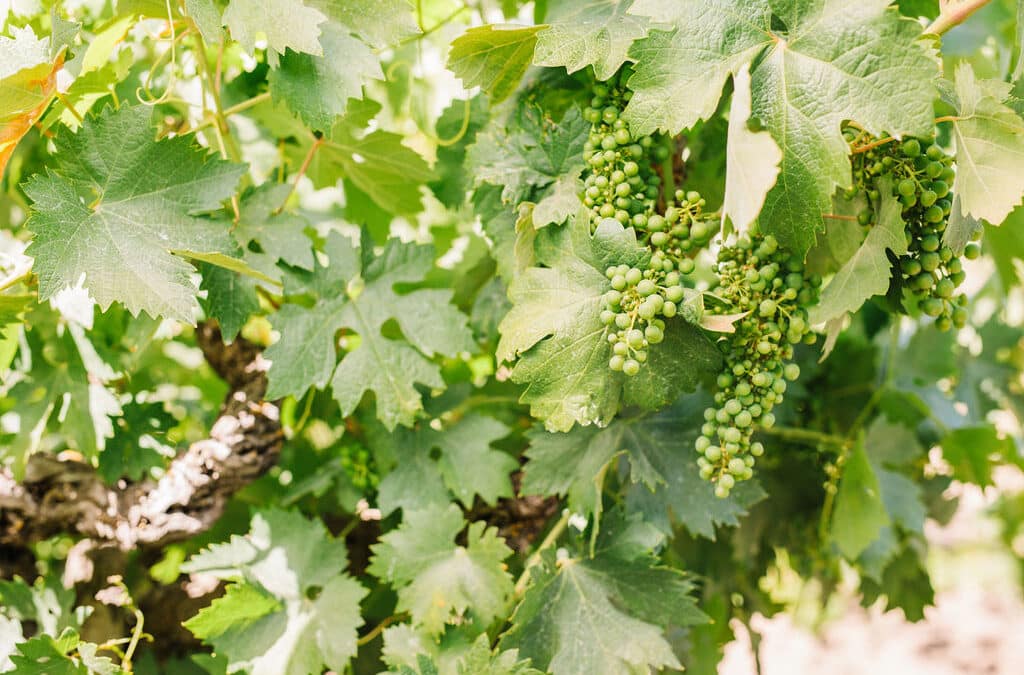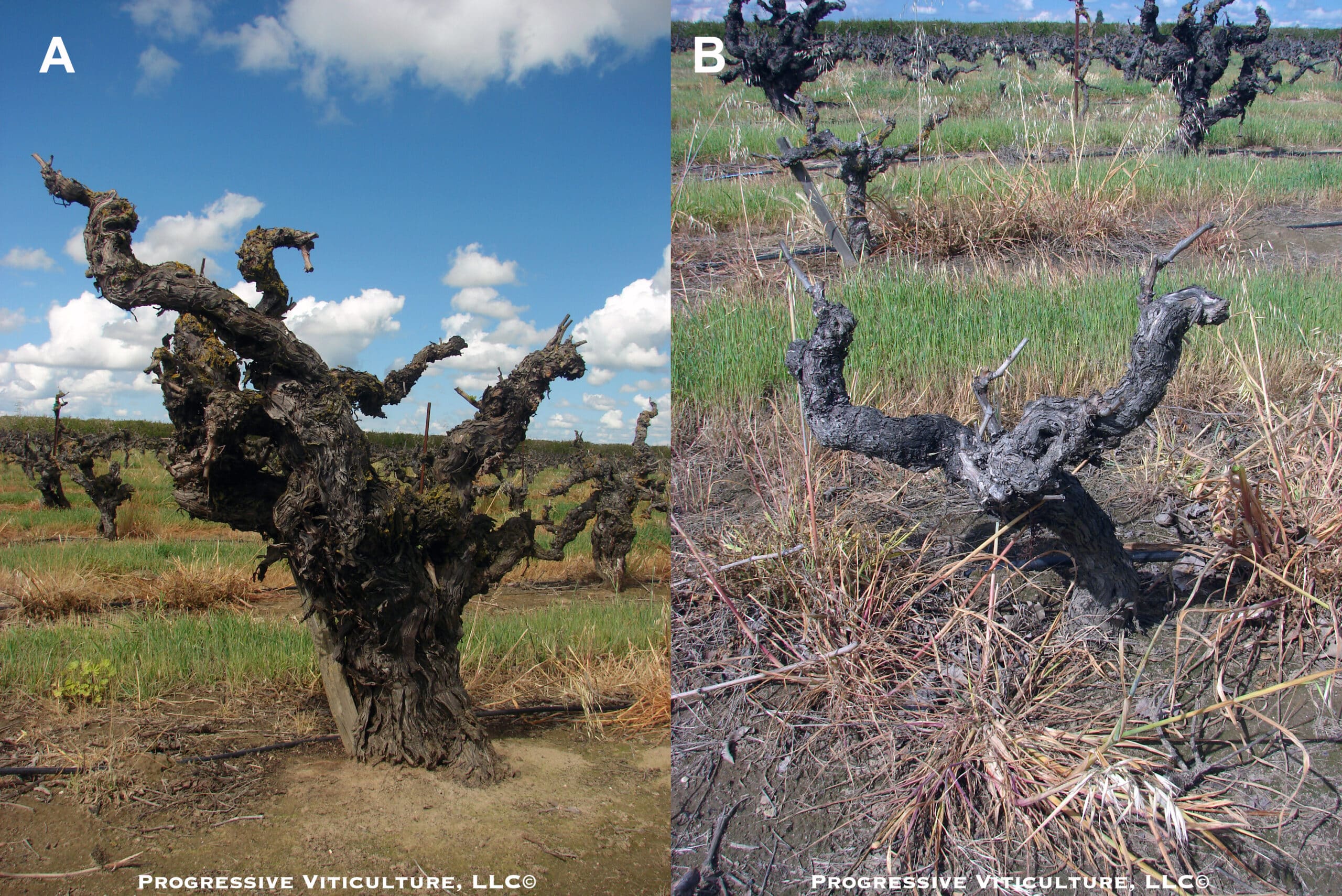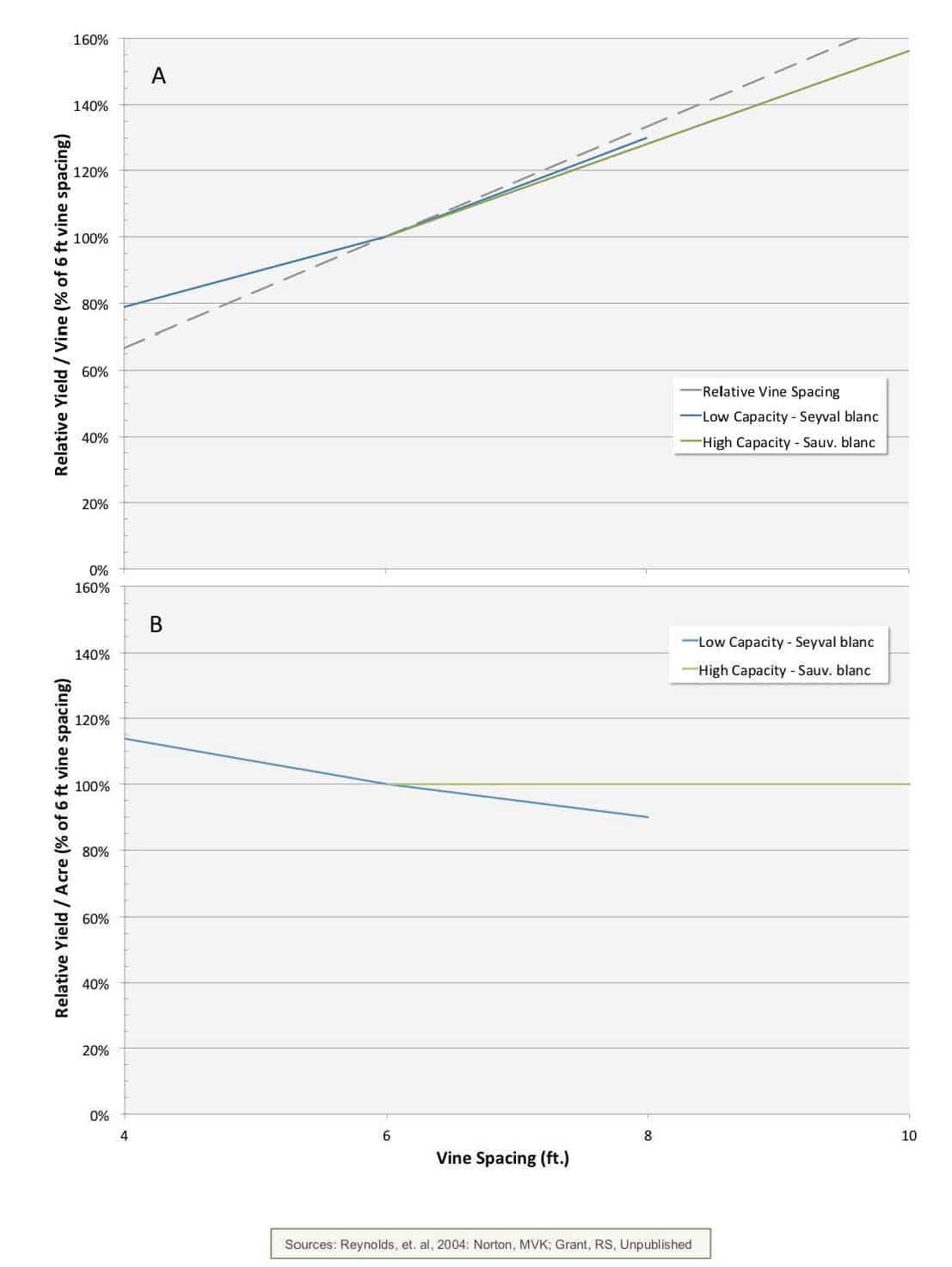MONDAY, MAY 20, 2024. BY STAN GRANT, VITICULTURIST.
Grapevine fruit yield is a destination. It is the culmination of several developmental processes during a two-year journey. The developmental path leading to fruit yield is complex (Figure 1).
Figure 1. Grapevine fruit yield is a complex journey involving multiple pathways and many components. (Source: Progressive Viticulture, LLC©).
We can influence some stages of the fruit yield development journey, while other stages we cannot. Our influences are limited to the effects of vineyard design and vineyard management inputs and practices. In this article, we will simplify the complexity of fruit yield by focusing on these two vineyard factors. In addition, we will discuss how we can promote efficient and sustainable fruit production through them.
Grapevine Growth Capacity: The Foundation of Fruit Yield
Every combination of grapevine variety and rootstock has a certain inherent potential for growth. And every vineyard site imposes limitations on the growth potential of a variety and rootstock. Past stresses and management actions or inactions may diminish vine growth potential. Accordingly, the growth potential of any given vine is the net result of these three factors – genetics, site, and history.
Capacity is the viticultural term for a vine’s potential for growth, including fruit growth and yield. It is a function of root system density and wood mass of the above-ground vine (Figure 2). Capacity reflects a vine’s potential to acquire, synthesize, and store resources.
Figure 2. Grapevine growth and production capacity is a function of wood mass and root system size and density. These photos show two head-trained vines with different capacities residing in the same vineyard. (Photo Source: Progressive Viticulture, LLC©)
Growth capacity is not the same as growth vigor, which is the rate of growth and not the potential for growth. Capacity is like wall voltage, while vigor is like the current in a cord running to an appliance. Capacity and vigor, however, are related in that high-capacity vines can easily produce high-vigor shoots, but low-capacity vines cannot. Correspondingly, so-called invigorating rootstocks are actually rootstocks that promote high growth capacity.
Fruit Yield and the Limits of Vine Growth Capacity
Grapevine training and pruning can impact the quantity of permanent vine wood and thereby, growth capacity. Such an impact is manifest in the reduction of fruit yield when canes replace cordons and spurs (Figure 3).
Figure 3. When canes replace cordons, the reduction in wood mass and vine capacity is reflected in reduced yields. (Data for combined average yields for two trials involving quadrilateral cordon-trained Sauvignon blanc vineyards. Canes replaced cordons during late winter of 1989 and new cordons were reestablished in subsequent years).
With increasing fruit zone height above the vineyard floor, canopy leaf area, and trunk length simultaneously increase. These increases provide greater photosynthetic capacity and nutrient storage, respectively. That being so, increased yields are the net effect of higher fruit zones. Nonetheless, yield increases are not proportionate to changes in fruit zone height (Figure 4). Moreover, the effects of increasing fruit zone height, while initially significant, diminish towards the limits of grapevine growth capacity.
Figure 4. Fruit yields increase with heightened fruit zones within the limits of grapevine capacity.
Horizontal canopy division doubles the amount of cordon and potentially, leaf area and photosynthetic capability per vine. While canopy division does, in fact, substantially increase fruit yields, it does not double them due to the limits of grapevine growth capacity (Figure 5).
Figure 5. Doubling the number of cordons and spurs did not double fruit yield due to the limits of vine capacity. (Data for combined average yields for 3 trials involving Chardonnay. All vines supported 7 feet of cordon in a bilateral configuration ).
Narrowing vine row spacing increases the number of vines, buds, and shoots per acre and consequently, the yield per acre. This effect is most apparent in cooler sites (e.g., Oakville) where grapevine growth capacity is lower than in warmer sites (e.g., Kearney) (Figure 6). In cooler sites, yield changes appear nearly proportionate to changes in row spacing. In warmer sites, competition for sunlight and soil resources among larger-capacity vines presumably limits the effects of narrowing row spacing on yields.
Figure 6. Vine densities and vineyard yields increase as rows are spaced more closely. This effect is especially beneficial for low-capacity grapevines.
Relative yield per vine is disproportionately large for closely spaced, low-capacity grapevines (e.g., Seyval blanc) where their canopies can fully develop and fill their allotted space (Figure 7A). For both low and high-capacity vines, yield per vine increases with increasing spacing, but at a rate that steadily decreases in proportion to the intensifying strain of additional shoots on capacity. Differences in the influences of growth capacity are more apparent for yield per acre, for which yield per acre for low-capacity vines declines and yield per acre for high-capacity vines appears stable within the range of these data (Figure 7B).
Figure 7. On a per-vine basis, yields of both low and high-capacity grapevines slowly increase as the space between vines increases. Yields of low-capacity vines especially benefit from close vine spacing in the row (A). On a per-acre basis, low-capacity vines fail to fully use increasing space and yields decrease accordingly, while yields of high capacity remain stable within the range of vines spacings studied (B).
To summarize, grapevine growth capacity is apparent in yield responses to changes in the spacing-training-trellising-pruning system (i.e., vineyard design). In practice, these responses are less than proportionate to the changes in vineyard design factors due to the limits of vine growth capacity. Advantageous use of grapevine growth capacity for fruit production commonly involves cordon training and spur pruning, high fruit zones, canopy division, and to the extent feasible, close row spacing, and for low-capacity vines, close vine spacing.
As mentioned earlier in this article, the combination of scion and rootstock influences grapevine growth capacity and as a result, fruit yield (Figure 8). Hence, plant material growth capacity ought to affect vineyard design decisions. Still, there are other factors that may be more important in the selection of a rootstock than its influence on vine growth capacity, with resistance to soil-borne pests and diseases usually being paramount.
Figure 8. Amador County Zinfandel fruit yields reflect the influence of rootstock vine capacity.
For part TWO, click HERE.
This article is based on a presentation delivered at the 2021 Mid Valley Agricultural Services Grape Grower Meeting. The author dedicates this article to Maxwell Norton, UC Cooperative Extension Farm Advisor Emeritus, his partner in many a viticultural research project in pursuit of an understanding of winegrape yield
Further Reading
Archer, E, and Strauss, HC. The effect of vine spacing on the vegetative and reproductive performance of Vitis vinifera L. (c. Pinot Noir). S. Afr. J. Enol Vitic. 6, 72-76. 1991.
Balasubrahmanyam, VR, and Diofasi. Vine behavior and wine composition in Italian Riesling grapes influenced by different cropping levels. Vitis. 18, 122-126. 1979.
Bernizzoni, F, Gatti, M, Civardi, S, and Poni, S. Long-term performance of Barbera grown under different training systems and within-row vine spacings. Amer. J. Enol. Vitic. 60, 339-348. 2009.
Bioletti, FT, and Winkler, AJ. Density and arrangement of vines. Hilgardia. 6, 179-195. 1935.
Bowen, P., Bogdanoff, C, Usher, K, Estergaard, B, and Watson, M. Effects of irrigation and crop load on gas exchanged and fruit composition of red winegrapes on a loamy soil. Am. J. Enol. Vitic. 62, 9-22. 2011.
Bucks, DA, French, OF, Nakayama, FS, and Fangmeier, DD. Trickle irrigation management for grape production. In Drip/trickle irrigation in action. Proc. 3rd International drip/trickle irrigation congress. Amer. Soc. Agric. Engin. St. Joseph, Michigan. p. 204-211. 1985.
Dokoozlian, N, and Verdegaal. Influence of in-row vine spacing on the performance of Syrah grapevines: a progress report. UC Grape Day. Parlier, CA. 2003.
Dokoozlian, N. Integrated canopy management: a twenty-year evolution in California. In Recent advances in canopy management; Univ. Calif., Davis. p. 43-52. July 16, 2009.
Edson, CE, Howell, GS, and Flore, JA. Influence of crop load on photosynthesis and dry weight partitioning of Seyval grapevines. I. Single leaf and whole leaf response pre- and post-harvest. Am. J. Enol. Vitic. 44, 139-147. 1993.
Edson, CE, Howell, GS, and Flore, JA. Influence of crop load on photosynthesis and dry weight partitioning of Seyval grapevines. II. Seasonal changes in single leaf and whole vine photosynthesis. Am. J. Enol. Vitic. 46, 469-477. 1995.
Edson, CE, Howell, GS, and Flore, JA. Influence of crop load on photosynthesis and dry weight partitioning of Seyval grapevines. III. Seasonal changes in dry matter partitioning, vine morphology, yield, and fruit composition. Am. J. Enol. Vitic. 46, 478-485. 1995.
Freeman, BM, Lee, TH, and Turkington, CR. Interaction of irrigation and pruning level on growth and yield of Shiraz vines. Amer. J. Enol. Vitic. 30, 218-223. 1979.
Geller, JP, and Kurtural, SK. Mechanical canopy and crop-load management of Pinot gris in a warm climate. Am J. Enol. Vitic. 64, 65-73. 2013.
Grimes, DW, and Williams, LE. Irrigation effects on plant water relations and productivity of Thompson Seedless grapevines. Crop Sci. 30, 255-260. 1990.
Giulio, C, Giaccone, M, Scognamiglio, P, Mataffo, A, Teobaldelli, M, and Basile, B. Vegetative, yield, berry quality response of Aglianico to shoot-trimming applied at three stages of berry ripening. Am. J. Enol. Vitic. 70, 351-359. 2019.
Gutierrez-Gamboa, G, Pardo, C, and Moreno-Simunovic, Y. Effects on berry shrinkage in Vitis vinifera L. ‘Merlot’ from changes in canopy/root ratio: a preliminary approach. S. Sfr. J. Enol. Vitic. 40, 47-52. 2019.
Hunter, DM, Wiebe, J, and Bradt, OA. Influence of fruit yields and quality on grape cultivars of differing vine vigor. J. Amer. Soc. Hort. Sci. 110, 590-596. 1985.
Intrieri, C, and Filippetti, I. Planting density and physiological balance: comparing approaches to European viticulture in the 21st century. In JM Rantz (ed.) Proc. ASEV 50th Anniversary Meeting, Seattle, WA. p. 296-308. 2000.
Intrieri, C, and Poni, S. Integration of grapevine training systems and mechanization in north-central Italy. Practical Winery and Vineyard. March-April. p. 65-71 and 82-83. 2005.
Jackson, DI, Steans, GF, and Hemmings, PC. Vine response to increasing node numbers. Amer. J. Enol. Vitic. 35, 161-163. 1984.
Jensen, F, Andris, H, Beebe, B, and Bettiga, L. The effects of row spacing, variety, and trellis on yields of three wine varieties. unpublished report. 1982.
Kasimatis, AN, Lider, LA, and Kliewer, WM. Trellising and training practices to influence yield, fruit composition, and growth of Chenin blanc grapevines. In Webb, AD (ed.) Grape and Wine Centennial Symposium Proceedings. Univ. Calif., Davis. pp. 386-389. 1983.
Kaps, ML, and Cahoon, GA. Growth and fruiting of container-grown Seyval blanc grapevines modified by changes in crop level, leaf number and position, and light exposure. Am. J. Enol. Vitic. 43, 191-199. 1992.
Keller, M, Smithyman, RP, and Mills, LJ. Interactive effects of deficit irrigation and crop load on Cabernet Sauvignon in an arid climate. Am. J. Enol. Vitic. 59, 221-234. 2008.
Keller, M. The science of grapevines. Academic Press, Burlington, MA. 2010.
Kliewer, WM, and Antcliff, AJ. Influence of defoliation, leaf darkening, and cluster shading on the growth and composition of ‘Sultana’ grapes. Am. J. Enol. Vitic. 21, 26-36. 1970.
Kliewer, WM, and Weaver, RJ. Effect of crop level and leaf area on growth, composition, and coloration of ‘Tokay’ grapes. Am. J. Enol. Vitic. 22, 172-177. 1971.
Kliewer, M, Benz, J, and Johnson, R. Spacing, pruning, and trellis effects on yield. Wines and Vines. February, 32-33. 1990.
Kliewer, WM, Wolpert, JA, and Benz, M. Trellis, and vine spacing effects on growth, canopy microclimate, yield, and fruit composition of Cabernet Sauvignon. Act Hort. 526, 21-31. 2000.
Kliewer, WM, and Dokoozlian, NK. Leaf area/crop weight ratios of grapevines: influence on fruit composition and wine quality. Am. J. Enol. Vitic. 56, 170-181. 2005.
Matthews, MA. Terroir and other myths. University of California Press, Oakland. 2015.
May, P, Sauer, MR, and Scholefield, PB. Effect of various trellis, pruning, and rootstocks on vigorous Sultana vines. Vitis. 12, 192-206. 1973.
Myers, JK, Wolpert, JA, and Howell, GS. Effect of shoot number on the leaf area and crop weight relationship of young Sangiovese grapevines. Am. J. Enol. Vitic. 59, 422-724. 2008.
Norton, MVK. Effect of pruning level on yield, fruit quality, and must characteristics of five winegrape varieties. San Joaquin Valley Grape Symposium Proceedings. December 7, 1994.
Norton, MVK, and Grant, RS. Effect of cordon retraining on yield, fruit quality, and must characteristics of Sauvignon blanc. Unpublished data. 1995.
Norton, MVK, and Grant, RS. Effect of cluster thinning on yield, fruit quality, and must characteristics of Burger. Unpublished data. 1995.
Norton, MVK, and Grant, RS. Effect of shoot thinning on yield, fruit quality, and must characteristics of Barbera. Unpublished data. 1995.
Nuzzo, V, and Matthews, MA. Response of fruit growth and ripening to crop level in dry-farmed Cabernet Sauvignon on four rootstocks. Am. J. Enol. Vitic. 57, 314-324. 2006.
Peacock, WL, Christensen, LP, and Andris, HL. Development of a drip irrigation schedule for average-canopy vineyards in the San Joaquin Valley. Amer. J. Enol. Vitic. 38, 113-119. 1987.
Poni, S, Casalini, L, Bernizzoni, F, Civardi, S, and Intrieri, C. Effects of early defoliation on shoot photosynthesis, yield components, and grape composition. Am. J. Enol. Vitic. 57, 397-407. 2006.
Poni, S, Zamboni, M, Vercesi, A, Garavani, A, and Gatti, M. Effects of early shoot trimming of varying severity on single high-wire Pinot noir grapevines. Am. J. Enol. Vitic. 65, 493-498. 2014.
Reynolds, AG. Riesling grapes respond to cluster thinning and shoot density manipulation. J. Amer. Soc. Hort. Sci. 114, 364-368. 1989.
Reynolds, AG, and Wardel, DA. Impact of training system and vine spacing on vine performance and berry composition of Seyval blanc. Amer. J. Enol. Vitic. 45, 444-451. 1994.
Reynolds, AG, Wardel, DA, and Naylor, A. Impact of training system and vine spacing on vine performance and berry composition of Chancellor. Amer. J. Enol. Vitic. 46, 88-97. 1995.
Reynolds, AG, Wardel, DA, and Naylor, A. Impact of training system, vine spacing, and basal leaf removal on Riesling. Vine performance, berry composition, canopy microclimate, and vineyard labor requirements. Amer. J. Enol. Vitic. 47, 63-76. 1996.
Reynolds, AG, Wardle, DA, Cliff, MA, and King, M. Impact of training system and vine spacing on vine performance, berry composition, and wine sensory attributes of Seyval and Chancellor. Amer. J. Enol. Vitic. 51, 84-95. 2004.
Reynolds, AG, Wardle, DA, Cliff, MA, and King, M. Impact of training system and vine spacing on vine performance, berry composition, and wine sensory attributes of Riesling. Amer. J. Enol. Vitic. 51, 96-103. 2004.
Luis, HML, Reynolds, AG, and Di Profio, F. Crop level and harvest date impact composition of four Ontario winegrape cultivars. I. Yield, fruit, and wine composition. Amer. J. Enol. Vitic. 68, 431-4463
Santesteban, LG, Miranda, C, and Royo, JB. Thinning intensity and water regime affect the impact of cluster thinning on grape quality. Vitis. 50, 159-165. 2011.
Shaulis, N, Kimball, K, and Tompkins, JP. The effect of trellis height and training system on the growth and yield of Concord grapes under controlled pruning severity. Proc. Amer. Soc. Hort. Sci. 62, 221-27. 1953.
Skinkis, PA, and Vance, AJ. Understanding vine balance: an important concept in vineyard management. Oregon State University Extension Service. June 2013.
Terry, DB, and Kurtural, SK. Achieving vine balance of Syrah with mechanical canopy management and regulated deficit irrigation. Am. J. Enol. Vitic. 62, 426-437. 2011.
Trought, M. Grapevine triangle. An aid to understanding grapevine balance. Wines and Vines. pp. 53-58. June 2017.
Weaver, RJ, and Kasimatis, AN. 1975. Effect of trellis height on with and without crossarms on yield of Thompson Seedless grapes. J. Amer. Soc. Hort. Sci. 100, 252-253. 1994.
Weaver, RJ, Kasimatis, AN, Johnson, JO, and Vilas, N. Effect of trellis height and crossarm width and angle on yield of Thompson Seedless grapes. Amer. J. Enol. Vitic. 35, 94-96. 1984.
Williams, LE, and Grimes, DW. Irrigation effects on plant water relations and productivity of Thompson Seedless. Crop Sci. 30, 255-260. 1990.
Williams, LE, and Grimes, DW. Modeling vine growth-development of a data set for a water balance subroutine. In Proc. 6th Ann. Aust. Wine Indus. Tech. Conf. p. 169-174.1996.
Williams, L, Grimes, SW, Peacock, WL, and Phene, CJ. Irrigation amounts needed to optimize yields of Thompson Seedless grapevines. Unpublished report. 1994.
Winkler, AJ. Effect of vine spacing in an unirrigated vineyard on vine physiology, production, and wine quality. Amer. J. Enol. Vitic. 20, 7-15. 1969.
Winkler, AJ. The relation of leaf area and climate to vine performance and grape quality. Amer. J. Enol. Vitic. 9, 10-23. 1958.
Winkler, AJ, Cook, JA, Kliewer, WM, and Lider, LA. General Viticulture. University of California, Berkeley. 1974.
Winter, E, and Whiting, J. Using leaf area and crop weight to determine vine balance. Aust. Vitic. Jan-Feb, 2004.
Have something interesting to say? Consider writing a guest blog article!
To subscribe to the Coffee Shop Blog, send an email to stephanie@lodiwine.com with the subject “blog subscribe.”
To join the Lodi Growers email list, send an email to stephanie@lodiwine.com with the subject “grower email subscribe.”
To receive Lodi Grower news and event promotions by mail, send your contact information to stephanie@lodiwine.com or call 209.367.4727.
For more information on the wines of Lodi, visit the Lodi Winegrape Commission’s consumer website, lodiwine.com.
For more information on the LODI RULES Sustainable Winegrowing Program, visit lodigrowers.com/standards or lodirules.org.










